Merope, 23 Tauri (23 Tau) is a blue-white subgiant star located in the constellation Taurus. It is one of the brightest stars in the Pleiades cluster, one of the nearest and most prominent open star clusters in the sky. Merope has an apparent magnitude of 4.18 and lies at an approximate distance of 380 light years from Earth. It is the faintest of the stars representing the Seven Sisters.
Star system
Merope has the stellar classification B6IV(e), indicating a subgiant star appearing bluish in colour. The star has a mass about 4.5 times that of the Sun and a radius 5.1 times solar. With a surface temperature of 13,360 K, it shines with 630 solar luminosities. Merope is an exceptionally fast spinner, with a projected rotational velocity of at least 280 km/s at the equator.
Merope is classified as a Beta Cephei variable, showing variations in brightness of 0.01 magnitudes. Beta Cephei-type stars typically exhibit small, rapid changes in brightness as a result of pulsations of their surface. They usually belong to the spectral class B. Spica (Alpha Virginis) in the constellation Virgo, Mimosa (Beta Crucis) in Crux, Hadar (Beta Centauri) in Centaurus, Algenib (Gamma Pegasi) in Pegasus, Shaula (Lambda Scorpii) and Alniyat (Sigma Scorpii) in Scorpius, and Mirzam (Beta Canis Majoris) in Canis Major are among the best known examples.
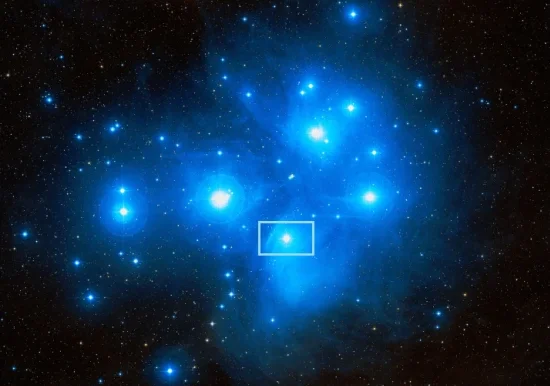
Merope (23 Tauri), image: Wikisky
Merope Nebula
Merope is enveloped in a nebulosity catalogued as NGC 1435 in the New General Catalogue and sometimes also called Tempel’s Nebula, after Wilhelm Tempel, the German astronomer who discovered it on October 19, 1859. The diffuse reflection nebula is the brightest around the star, where it has an apparent magnitude of 13. Most of it, however, is fainter than magnitude 16.
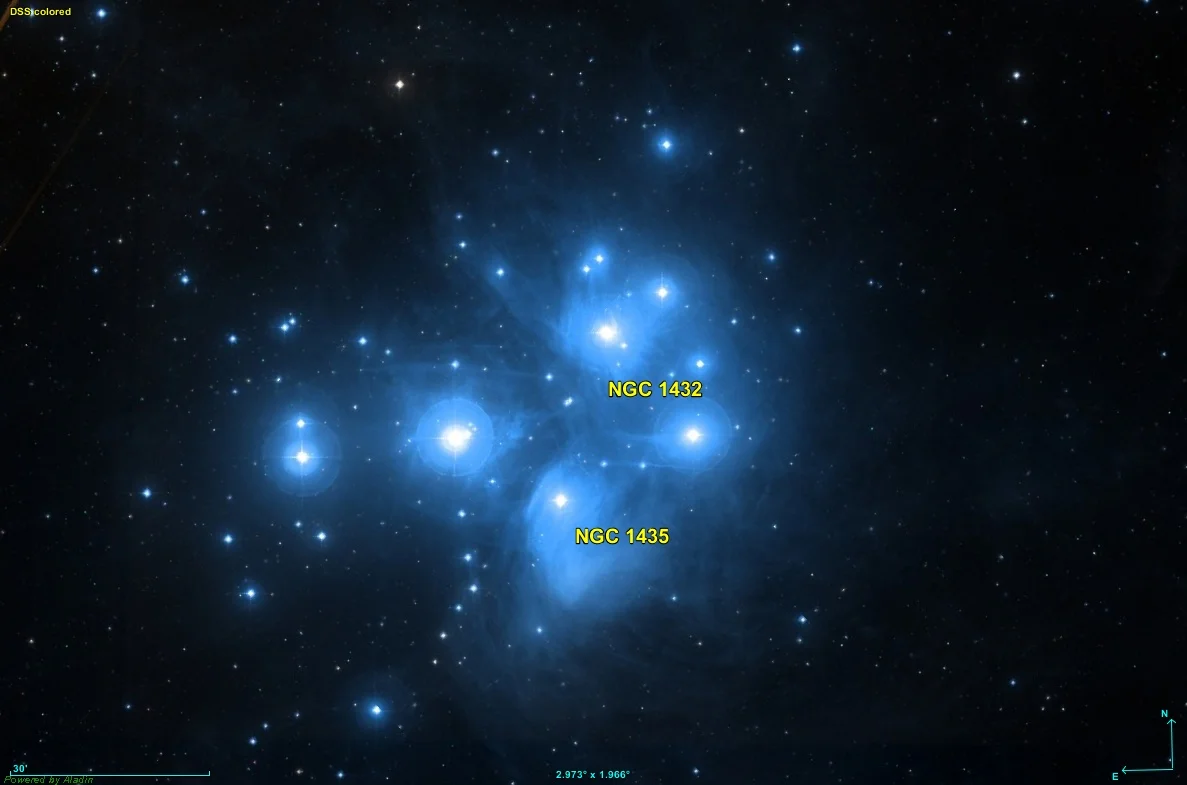
Maia Nebula (NGC 1432) and Merope Nebula (NGC 1435), image: Donald Pelletier
The Merope Nebula is part of a larger region of reflection nebulosity that envelops the Pleiades. It was once believed to be what remained of the cloud in which the stars formed but is now known to be unrelated to the cluster. It is merely an interstellar dust cloud through which the Pleiades stars are currently passing. The cloud is slowly being destroyed by the stars’ passage.
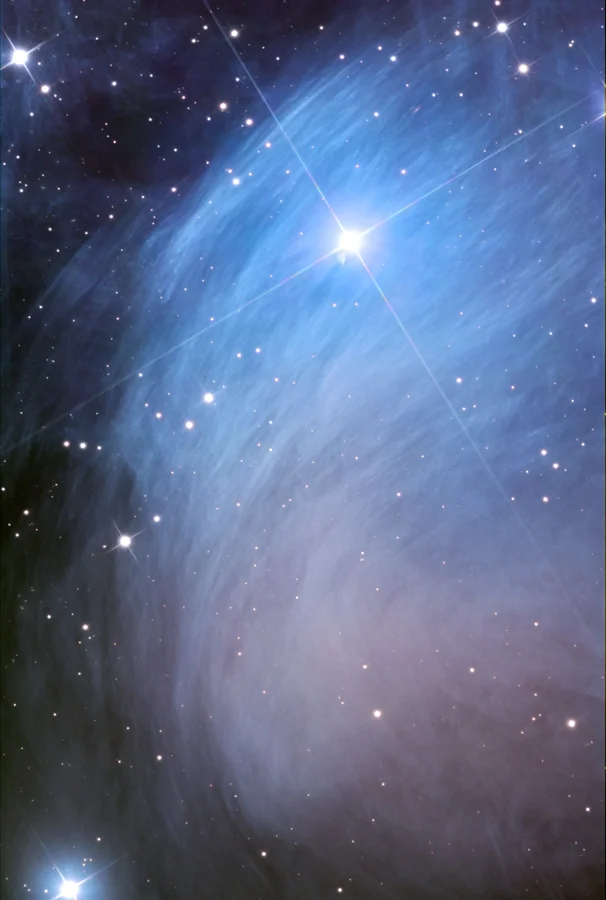
Merope Nebula, image: Adam Block/Mount Lemmon SkyCenter/University of Arizona (CC BY-SA 4.0)
The nebula contains a bright knot, catalogued as IC 349 and located 36’’ northwest of Merope. The knot is roughly half an arcminute wide. It was discovered by the American astronomer Edward Emerson Barnard in November 1890 and is also known as Barnard’s Merope Nebula.
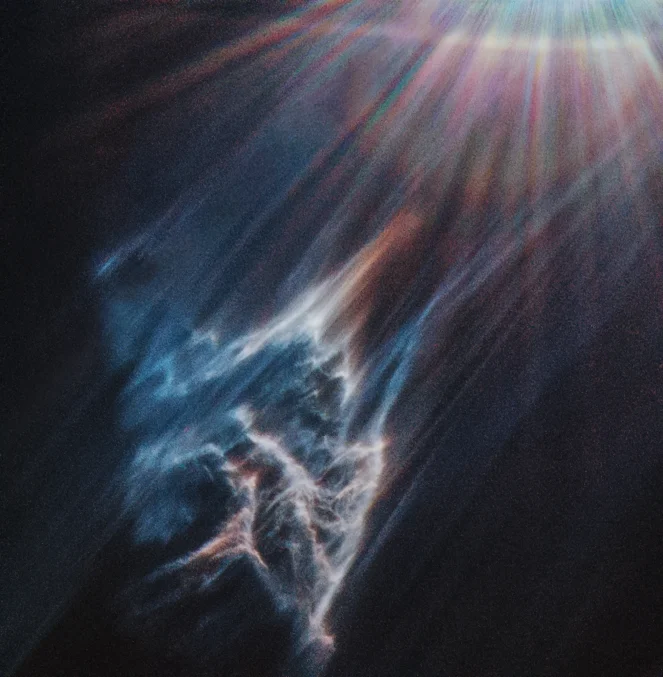
IC 349, image: Judy Schmidt (CC BY 2.0)
Pleiades
The Pleiades cluster is one of the most familiar features of the winter sky in northern latitudes. It stretches across an area of 110 arcminutes and has a visual magnitude of 1.6. Its brightest members are young, hot class B stars that formed in the last 100 million years, located at an average distance of 444 light years from the Sun.
The cluster contains over 1,000 known members and many more dim and unresolved stars. Observers can usually see six to eight stars, but up to 14 members are bright enough to be visible without binoculars in exceptionally good conditions.
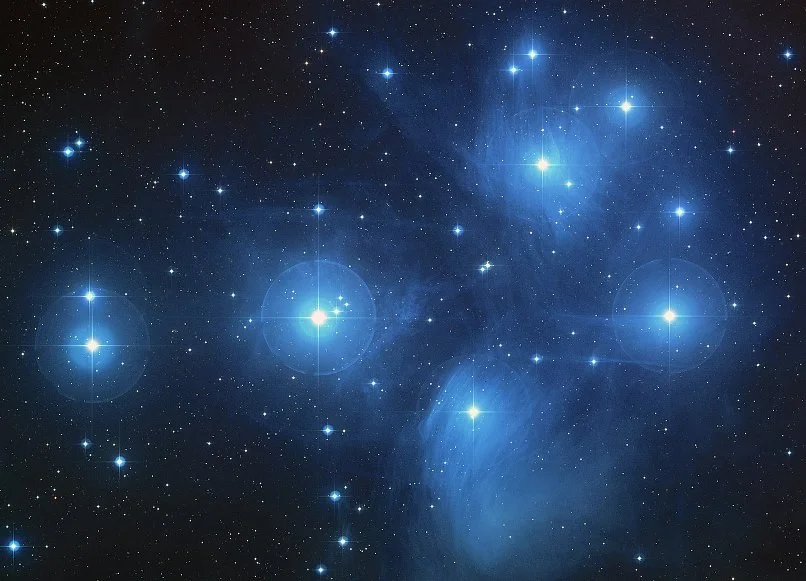
The Pleiades (M45), image: NASA, ESA, AURA/Caltech, Palomar Observatory, credit: D. Soderblom and E. Nelan (STScI), F. Benedict and B. Arthur (U. Texas), and B. Jones (Lick Obs.)
The cluster was catalogued as Messier 45 (M45) by the French astronomer Charles Messier. The Messier catalogue is a compilation of deep sky objects that may be confused for comets and the inclusion of the Pleiades is curious because the cluster has been well-known to observers since ancient times.
The stars in the cluster formed in the same molecular cloud at about the same time and they share a common proper motion. They will keep moving together through space for about another 250 million years before they gradually disperse due to gravitational interaction with the interstellar medium.
The nine brightest members of the cluster are named after the Pleiades, the Seven Sisters in Greek mythology – Alcyone (Eta Tauri), Asterope (21 Tauri), Celaeno (16 Tauri), Electra (17 Tauri), Maia (20 Tauri), Merope (23 Tauri) and Taygeta (19 Tauri) – and their parents Atlas (27 Tauri) and Pleione (28 Tauri).
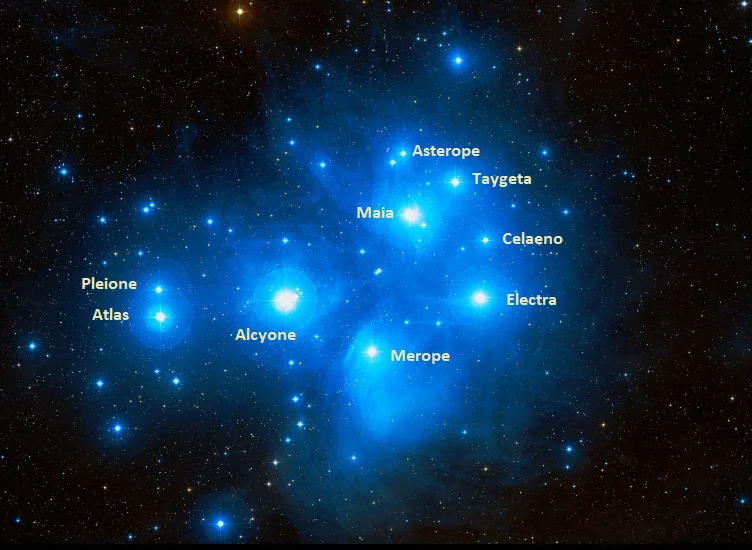
The Pleiades, image: Wikisky
In mythology, Atlas was one of the Titans who fought a war against the Olympian gods and felt the consequences of defeat. As punishment, he was forced to uphold the heavens on his shoulders. Orion, a giant huntsman who was attracted to Atlas’ seven daughters, saw his opportunity and started pursuing them. Zeus put a stop to this, transforming the sisters into doves and then into stars to console their father. It is said that Orion (the constellation) is still pursuing the Pleiades across the sky.
Facts
Merope is often referred to as the “lost Pleiad” because it is the faintest of the seven stars representing the Pleiades and not as easily seen as the others.
The Pleiades cluster has been known to observers in cultures across the globe since ancient times. The earliest depiction of its brightest stars was found on the Nebra sky disk, a Bronze Age artifact discovered in Germany dating back to around 1600 BCE. The Pleiades were mentioned in a number of well-known ancient texts, including the Bible, Homer’s Iliad and Odyssey, and Hesiod’s Works and Days.
Italian physicist and astronomer Galileo Galilei was the first to see the cluster in a telescope. He discovered that it contained countless other stars that were too visible to be seen by the unaided eye. Galilei published his notes and a sketch of the cluster in March 1610.
In Japan, the cluster is known as Subaru. The car company of the same name uses an image of its six brightest stars in its logo. In the 8th century Kojiki (“An Account of Ancient Matters”), an early compilation of Japanese myths, legends and oral traditions, the cluster is mentioned as Mutsuraboshi, or “six stars.”
Merope was one of the star names used in the Harry Potter series, along with Sirius, Regulus, and Bellatrix. Merope Riddle was the name of Lord Voldemort’s mother.
Name
The name Merope (pronunciation: /ˈmɛrəpiː/) comes from Greek mythology. The star was named after one of the Pleiades, the seven daughters of the Oceanid nymph Pleione and the Titan Atlas. Merope (Greek: Μερόπη) was the youngest of the seven sisters and the only one to have married a mortal. Her husband Sisyphus, the king of Ephyra, was condemned to roll a large boulder up a hill for eternity as punishment for his deceitfulness.
The name Merope was officially approved by the International Astronomical Union’s (IAU) Working Group on Star Names (WGSN) on July 20, 2016. It formally applies only to the component 23 Tauri Aa.
The Chinese know Merope as the Fifth Star of Hairy Head. Hairy Head is an asterism formed by the Pleiades stars Asterope, Atlas, Electra, Maia, Merope, Taygeta, and Alcyone. It is one of the seven mansions of the White Tiger.
Location
Merope is relatively easy to locate because it is a member of one of the most prominent open clusters in the sky. The Pleiades cluster is easily spotted on its own because it appears as a bright bunch of grapes, but it can also be found using the three bright stars of Orion’s Belt, Alnitak, Alnilam and Mintaka. It lies along the imaginary line extended from the Belt stars past Aldebaran, the brightest star in Taurus.
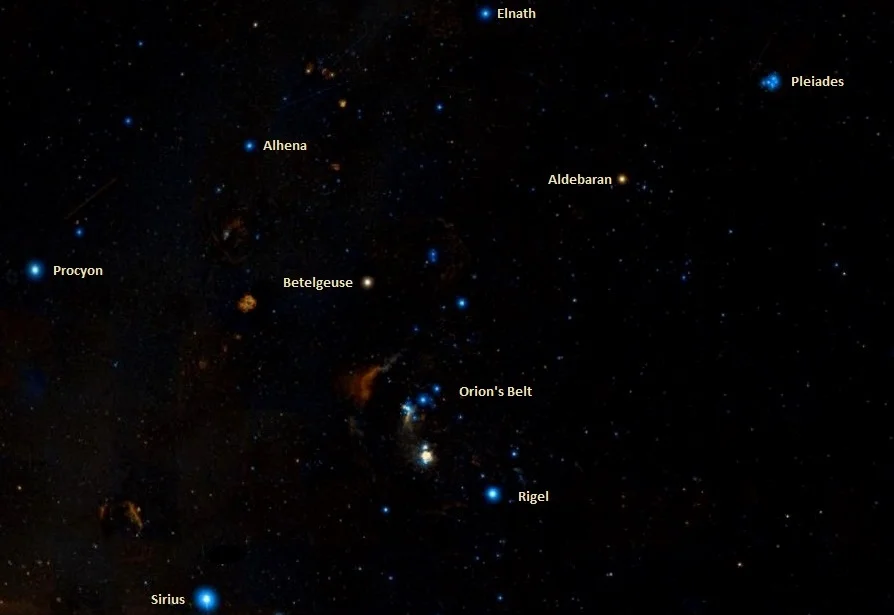
Pleiades location, image: Wikisky
The cluster is prominent in the northern sky from October to April. In May and June, it is too close to the Sun and stays invisible to observers at night.
Constellation
Merope is located in Taurus, one of the largest and best-known constellations in the sky. Belonging to the zodiac family of constellations, Taurus is one of the 48 Greek constellations, first listed by the Greco-Roman astronomer Ptolemy in the 2nd century CE. It occupies 797 square degrees of the northern sky.
Taurus is best-known for its luminary Aldebaran, the 14th brightest star in the sky, and for the two conspicuous open star clusters, the Pleiades and the Hyades. The Hyades outline the V-shaped head of the celestial Bull and Aldebaran marks the Bull’s eye, appearing as the cluster’s brightest member even though it is much closer to us than the Hyades. The Pleiades cluster marks the Bull’s shoulder.
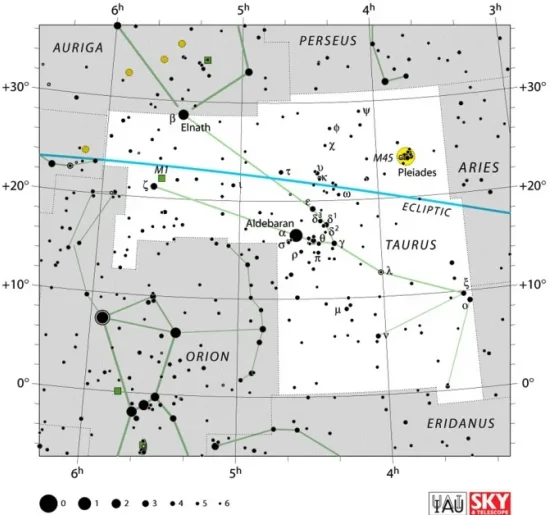
Taurus constellation map by IAU and Sky&Telescope magazine
Taurus contains several other notable deep sky objects: the Crab Nebula (Messier 1), the bright remnant of a historic supernova, Hind’s Variable Nebula (NGC 1555), a reflection nebula that exhibits changes in brightness due to being illuminated by the young variable star T Tauri, the Crystal Ball Nebula (NGC 1514), a planetary nebula named for its curious appearance, the open clusters NGC 1647 and NGC 1817, and the merging galaxies NGC 1409 and NGC 1410.
The best time of year to observe the stars and deep sky objects of Taurus is during the month of January.
The 10 brightest stars in the constellation are Aldebaran (Alpha Tau, mag. 0.86), Elnath (Beta Tau, mag. 1.65), Alcyone (Eta Tau, mag. 2.87), Tianguan (Zeta Tau, mag. 2.97), Chamukuy (Theta2 Tauri, mag. 3.40), Lambda Tauri (mag. 3.47), Ain (Epsilon Tau, mag. 3.53), Omicron Tauri (mag. 3.61), Atlas (27 Tau, mag. 3.63), and Prima Hyadum (Gamma Tau, mag. 3.654).
Merope – 23 Tauri
| Spectral class | B6IV(e) |
| Variable type | Beta Cephei |
| U-B colour index | -0.41 |
| B-V colour index | -0.06 |
| Apparent magnitude | 4.18 |
| Distance | 380 ± 20 light years (117 ± 5 parsecs) |
| Parallax | 8.58 ± 0.37 mas |
| Radial velocity | 6.2 km/s |
| Proper motion | RA: 21.13 mas/yr |
| Dec.: -43.65 mas/yr | |
| Mass | 4.5 M☉ |
| Luminosity | 630 L☉ |
| Radius | 5.1 R☉ |
| Temperature | 13,360 ± 340 K |
| Rotational velocity | 280 km/s |
| Surface gravity | 4.0 cgs |
| Constellation | Taurus |
| Right ascension | 03h 46m 19.57384s |
| Declination | +23° 56′ 54.0812″ |
| Designations | Merope, 23 Tauri, 23 Tau, V971 Tauri, HD 23480, HR 1156, HIP 17608, GC 4512, GCRV 2108, SAO 76172, BD 23° 522, CCDM J03463+2357A, AAVSO 0340+23, WDS J03463+2357A, IRAS 03433+2347, 2MASS J03461958+2356541, NSV 1287, PPM 92859, TYC 1800-2204-1, Gaia DR2 65205373151673344 |